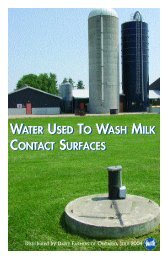Canadian Quality Milk On-Farm Food Safety Program - Centre ...
Canadian Quality Milk On-Farm Food Safety Program - Centre ...
Canadian Quality Milk On-Farm Food Safety Program - Centre ...
You also want an ePaper? Increase the reach of your titles
YUMPU automatically turns print PDFs into web optimized ePapers that Google loves.
<strong>Canadian</strong> <strong>Quality</strong> <strong>Milk</strong><br />
HAZARD SOURCE BEST MANAGEMENT PRACTICES<br />
• Mixing errors Clean-up spills.<br />
Apply fertilizer only at recommended rates.<br />
Calibrate application equipment.<br />
Harrow re-distributed fertilizer.<br />
See Chapter 1.<br />
Wood preservatives • Treated lumber Do not use treated lumber for feed bunk<br />
surfaces, stall bases, or platform of free stalls.<br />
Do not store feed in contact with treated lumber.<br />
Do not use bedding made from treated materials.<br />
See Chapter 1.<br />
Contamination of milk<br />
with chemical residues<br />
• Cleaning solutions<br />
• Pesticides (e.g.<br />
insecticides and<br />
rodenticides)<br />
• Overuse of cleaning<br />
products<br />
• Incomplete drainage of<br />
milking equipment (milk<br />
pipelines, receiver jar<br />
and bulk tank)<br />
• Improper storage of<br />
chemicals<br />
• Faulty safety switch<br />
• Improper removal of<br />
udder washes, teat dips<br />
and udder salves from<br />
teats before milking<br />
Use approved products according to accessible<br />
cleaning and sanitizing chart.<br />
Install a safety switch or fail safe system or check<br />
function of existing one.<br />
Have wash system evaluated annually.<br />
Store chemicals in a location and manner that will<br />
not contaminate milk or meat.<br />
Store in properly identified and labeled containers.<br />
Use milk house exclusively for cooling and storing<br />
milk and for cleaning, sanitizing and storing<br />
materials and equipment used in the production<br />
and handling of milk.<br />
Have a written plan on how to deal with a situation<br />
where pre-rinse or wash water has contaminated<br />
milk.<br />
Inspect equipment to ensure all water is drained<br />
prior to milking.<br />
Check pipeline for back slopes and adjust if<br />
necessary.<br />
Have a written plan outlining how to deal with a<br />
situation when milk is contaminated.<br />
See Chapter 7.<br />
Ensure teats are cleaned and dried.<br />
Use an approved teat sanitizing product and use<br />
it according to the label directions.<br />
Follow label directions when preparing udder<br />
washes and teat dips.<br />
See Chapter 5.<br />
Mercury • Mercury vacuum gauge Replace with a suitable gauge.<br />
See Chapter 7.<br />
June 2010 Appendix I - 7
















